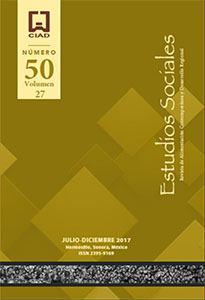El tianguis de cambio de Pátzcuaro, Michoacán a través del Metabolismo Social desde Mesoamérica hasta el siglo XXI
The tianguis de cambio of Patzcuaro, Michoacan through Social Metabolism since Mesoamerica until XXI century
Resumen
Objetivo. El tianguis de Pátzcuaro se analiza desde la perspectiva multidisciplinaria del Metabolismo Social, desde la época precolombina hasta la actualidad. Se enfatizan las fases de circulación y consumo para conocer sus cambios y permanencias y los posibles factores que inciden para que siga existiendo. Metodología. A partir de información del archivo histórico de la región, revisión bibliográfica, entrevistas a participantes del mercado, así como observación participante reciente, se aborda el metabolismo social y se destacan dos de sus fases: consumo y circulación. Resultados. El mercado ha ofrecido una diversidad de bienes y el 99% de los asistentes realiza trueque bajo reglas consuetudinarias. El maíz es el producto más solicitado. La oferta de productos ha cambiado por múltiples factores entre los que se encuentra el continuo cambio sociocultural y la disponibilidad, pero se mantienen elementos de una cultura alimentaria que es parte de su identidad y necesidades. Limitaciones y conclusiones. Desde el surgimiento de este mercado hasta su condición actual, las dinámicas y formas económicas que incluyen desde la apropiación y transformación de los recursos naturales, así como las formas de circulación y consumo, se podrían considerar artesanales y tradicionales, de baja escala, escaso uso de maquinaria y capital y predominancia de fuerza de trabajo propia. El intercambio a través del trueque se desarrolla en un contexto de economía solidaria que repercute en la pervivencia del mercado. Se evidencia la necesidad de generar investigaciones que profundicen la información del resto de las fases.
Palabras clave:
Alimentación contemporánea, metabolismo social, mercado de Pátzcuaro, intercambio no monetario, trueque, economía solidariaAbstract
Objective: Patzcuaro tianguis is analyzed from the multidisciplinary perspective of Social Metabolism, with emphasis in circulation and consumption phases. This is from the pre-Columbian era to the present time. The purpose is to know its changes and permanence and the possible factors that influence it to continue existing. Methodology: Based on information from region´s historical archive, bibliographic review, interviews with market participants, as well as recent participant observation, the five phases of the proposal of social metabolism are addressed. Results: The market has offered a diversity of goods and 99% of the assistants make barter under customary rules, where corn is the most requested product. The supply of products had been changed by many factors, including continuous socio-cultural change, availability but elements of a food culture that are part of their identity and needs remain. Limitations and conclusions: From the emergence of this market to its present condition, the dynamics and economic forms that include from the appropriation and transformation of natural resources, as well as the forms of circulation and consumption, could be considered traditional and small scale, scarce use of machinery and capital, and predominance of own workforce. The exchange through barter takes place in a context of solidarity economy that has repercussions on the survival of the market. It is evident the need to generate research that deepens the information of the rest of the phases.
Keywords:
Contemporary food, Purepecha, Patzcuaro Lake, non-monetary exchange, barter, solidarity economyDescargas
Publicado
Cómo citar
Número
Sección
Para que sean publicados artículos, ensayos y reseñas críticas en Estudios Sociales, la revista debe contar con la aceptación de parte de los autores/autoras de las condiciones siguientes:
1. Los autores conservan los derechos de autor y ceden a la revista el derecho de la primera publicación del trabajo registrado bajo la licencia de Creative Commons Reconocimiento-NoComercial (CC-By-NC) que permite a terceros utilizar lo publicado, siempre y cuando mencionen la autoría del trabajo y a la primera publicación en esta revista.
2. Los autores pueden realizar otros acuerdos contractuales independientes y adicionales para la distribución no exclusiva de la versión del artículo publicado en esta revista (por ejemplo: incluirlo en un repositorio institucional o publicarlo en un libro) siempre y cuando indiquen, claramente, que el trabajo se publicó por primera vez en esta revista.




















